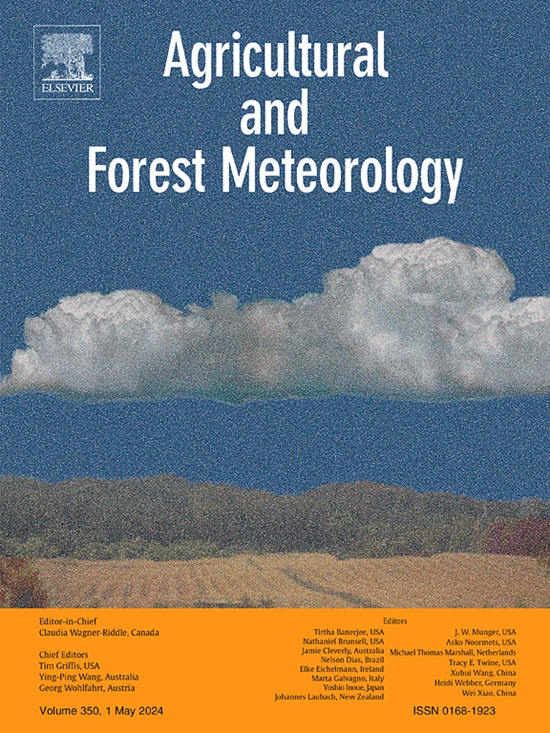通过作物模型将基因组预测扩展到未来气候。大麦抽穗时间的实例研究
IF 5.6
1区 农林科学
Q1 AGRONOMY
引用次数: 0
摘要
整合基因组预测(GP)和生物物理作物模型有可能支持植物育种确定适应气候变化的策略。然而,这种综合方法是否能将预测范围扩大到未开发的环境尚不清楚。我们展示了作物模型如何将GP扩展到新的环境,并捕获对未来气候条件的基因型特异性反应。考虑到物候在作物适应中的主要作用,以春大麦的抽穗期为例进行了研究。使用了151个两行基因型的表型和基因组(50 K Illumina SNP阵列)数据,对从地中海盆地到北欧的17个位点×季节组合进行了HD测定。通过整合WARM和WOFOST作物模型的方法,开发了一个专用的建模解决方案,并使用优化算法来获得大多数相关模型参数的特定值。利用R包rr-BLUP对模型参数进行GP处理,得到的标记衍生参数用于模拟抽穗日期,作物模型明确再现G × E × M相互作用。通过十倍交叉验证评估未知基因型的预测准确性,而作物模型将GP扩展到未开发环境的能力则通过留一个位点的交叉验证进行评估。结果令人鼓舞,未知环境中未知基因型的平均R2、RMSE和Nash-Sutcliffe效率分别为0.97、9.27和0.94。在未来气候条件下(以2060年为中心为IPSL-CM6A-LR实现SSP3-7.0生成的20个季节),特定作物的HD突出了大的G × E × M相互作用,证实了整合作物建模和GP以支持以适应气候变化为目标的育种计划的潜力。本文章由计算机程序翻译,如有差异,请以英文原文为准。
Extending genomic prediction to future climates through crop modelling. A case study on heading time in barley
Integrating genomic prediction (GP) and biophysical crop models has the potential to support plant breeding in defining adapting strategies to climate change. However, whether this integrated approach can actually broaden the prediction domain to unexplored environments is still unclear. We showed how crop models can extend GP to new environments and capture genotype-specific response to future climate conditions.
Days to heading (HD) in spring barley was used as a case study, given the primary role of phenology for crop adaptation. Phenotypic and genomic (50 K Illumina SNP array) data for 151 two-row genotypes were used, with HD determined on 17 site × season combinations spread from the Mediterranean basin to Northern Europe. A dedicated modelling solution was developed by integrating approaches from the WARM and WOFOST crop models, with optimization algorithms used to derive accession-specific values of most relevant model parameters. GP was carried out on the model parameters with the R package rr-BLUP, and the resulting markers-derived parameters were used to simulate heading date with the crop model explicitly reproducing G × E × M interactions. Prediction accuracy for unknown genotypes was evaluated through ten-fold cross validation, whereas the capability of crop models to extend GP to unexplored environments was evaluated with a leave-one site-out cross validation.
Results were encouraging, with average R2, RMSE and Nash-Sutcliffe efficiency for unknown genotypes in unexplored environments equal to 0.97, 9.27, and 0.94, respectively. Accession-specific HD under future climates (20 seasons centred on 2060 generated for the IPSL-CM6A-LR realization of SSP3–7.0) highlighted large G × E × M interactions, confirming the potential of integrating crop modelling and GP to supporting breeding programs targeting adaptation to climate change.
求助全文
通过发布文献求助,成功后即可免费获取论文全文。
去求助
来源期刊
CiteScore
10.30
自引率
9.70%
发文量
415
审稿时长
69 days
期刊介绍:
Agricultural and Forest Meteorology is an international journal for the publication of original articles and reviews on the inter-relationship between meteorology, agriculture, forestry, and natural ecosystems. Emphasis is on basic and applied scientific research relevant to practical problems in the field of plant and soil sciences, ecology and biogeochemistry as affected by weather as well as climate variability and change. Theoretical models should be tested against experimental data. Articles must appeal to an international audience. Special issues devoted to single topics are also published.
Typical topics include canopy micrometeorology (e.g. canopy radiation transfer, turbulence near the ground, evapotranspiration, energy balance, fluxes of trace gases), micrometeorological instrumentation (e.g., sensors for trace gases, flux measurement instruments, radiation measurement techniques), aerobiology (e.g. the dispersion of pollen, spores, insects and pesticides), biometeorology (e.g. the effect of weather and climate on plant distribution, crop yield, water-use efficiency, and plant phenology), forest-fire/weather interactions, and feedbacks from vegetation to weather and the climate system.

 求助内容:
求助内容: 应助结果提醒方式:
应助结果提醒方式:


